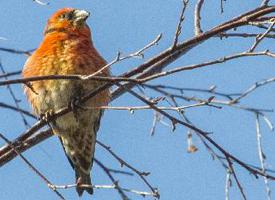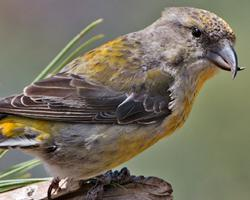
Váhy a míry
| Délka | od 12,5 do 14 cm |
|---|---|
| Hmotnost | 14 g |
Stav ohrožení
| Neohrožen |
Popis zvířete
The Common Redpoll (Acanthis flammea) is a small, charismatic finch that graces the northern and arctic regions of the globe with its presence. Known for its remarkable adaptability and striking plumage, this bird is a favorite among birdwatchers and nature enthusiasts alike.Typically measuring between 12 to 14 centimeters in length and weighing approximately 11 to 20 grams, the Common Redpoll is a diminutive bird with a relatively large head and a short, conical bill that is adept at handling its primary food source, seeds. The most distinctive feature of this species is the vibrant red patch found on the forehead, which is particularly pronounced in males and gives the bird its common name. The chest is adorned with a delicate, rosy flush that varies in intensity, further adding to the bird's charming appearance.
The back and wings of the Common Redpoll are characterized by a mottled brown and white pattern, providing excellent camouflage against the wintry landscapes it often inhabits. The belly and undertail coverts are white, sometimes with fine, dark streaks. One of the bird's more subtle features is its notched tail, which, along with its pointed wings, aids in its agile flight.
Common Redpolls are highly sociable birds, frequently forming large flocks outside of the breeding season. These flocks can sometimes include hundreds of individuals, creating a spectacular sight as they descend on feeders or natural food sources. Their diet primarily consists of seeds from birch, alder, and coniferous trees, but they also consume small insects during the breeding season.
Adaptability is a hallmark of the Common Redpoll's lifestyle. These birds are capable of surviving extremely cold temperatures, thanks in part to their ability to store seeds in an expanded esophagus section called a crop. This allows them to feed intensively during the short arctic days and metabolize the stored seeds overnight to maintain their body temperature.
Breeding typically takes place from May to July, with nests constructed in low shrubs or on the ground, well-hidden from potential predators. The female lays a clutch of 4 to 6 eggs, which she incubates for about 11 days. The young are then fed by both parents and fledge approximately two weeks after hatching.
Common Redpolls are migratory birds, with populations moving southward from their breeding grounds in the Arctic tundra and boreal forests to spend the winter in more temperate regions. This migration can vary annually, depending on food availability, leading to irruptions where large numbers of redpolls appear in areas where they are not usually found.
Despite facing challenges such as habitat loss and climate change, the Common Redpoll is currently classified as Least Concern by the International Union for Conservation of Nature (IUCN), indicating a stable global population. However, continued monitoring is essential to ensure that this delightful bird remains a common sight in its natural habitat.
Podobná zvířata
Nové fotografie zvířat
Top 10 zvířat
- Dolphin gull (Leucophaeus scoresbii)
- Diana monkey (Cercopithecus diana)
- Moustached guenon (Cercopithecus cephus)
- Stone loach (Barbatula barbatula)
- Greek tortoise (Testudo graeca)
- Galápagos tortoise (Geochelone nigra complex)
- Japanese macaque (Macaca fuscata)
- Common flying dragon (Draco volans)
- Russian tortoise (Testudo horsfieldii)
- Galápagos penguin (Spheniscus mendiculus)


